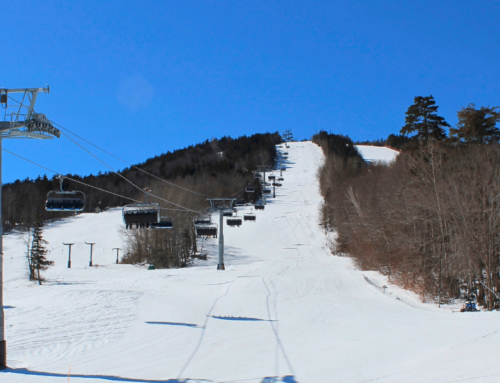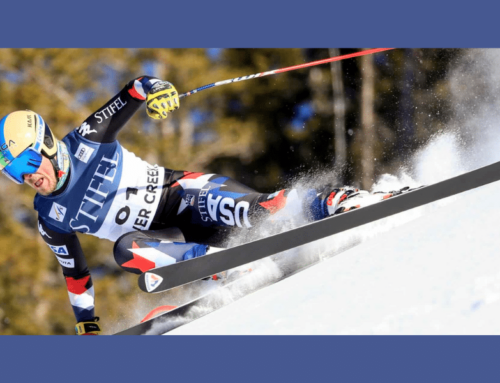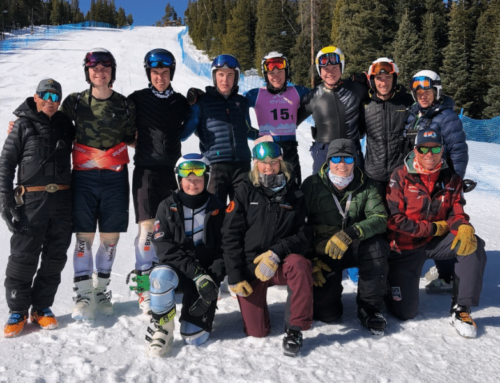Back to the future at Burke Mountain Academy
Felix McGrath and Diann Roffe return to their Vermont Roots with a strong mission
Editor’s note: This is part of an ongoing series articles Ski Racing Media will publish on the challenge of fundamental skill development in the U.S. In this installment, veteran writer Edie Thys Morgan takes a look Burke Mountain Academy’s new development philosophy and explores a few cost-cutting measures being taken at the Vermont boarding school.
Being on the hill at Burke Mountain this winter has felt like a flashback, featuring a couple of the U.S. Ski Team’s greatest athletes. Felix Mcgrath, as director of sport, and Diann Roffe, as junior program director, are shaping the current and next generation of top ski racers at Burke Mountain Academy. For both, it is a homecoming to Vermont and an opportunity to positively impact U.S. skiing.
McGrath did not attend Burke, but grew up an hour south on I-91, in Norwich, Vt. On the U.S. Ski Team he rose to become the third ranked slalom skier in the world. After retiring from amateur and then pro racing, McGrath coached the UVM ski team, and met his wife, a Norwegian Nordic skier. Since 2003, McGrath and his family have lived in Norway. There, he spent 10 years at the helm of Baerums Ski Club, which develops ski racers from their earliest touch with ski racing through the World Cup level.
For Roffe, a 1985 BMA graduate, World Champion and Olympic gold medalist, the opportunity at Burke is both personal and professional. While running the highly successful junior race program at Ski Roundtop in Pennsylvania, her then-10-year-old son attended Burke’s holiday camp in 2018. He loved it, prompting Burke headmaster Willy Booker to ask if Roffe would consider moving seasonally to Burke. When McGrath came on board last spring, it was a slam dunk.
Taking the long view
McGrath knows what it takes to build skiers and ski racers. The second run at this year’s Kitzbuhel World Cup slalom featured three Baerums racers, including McGrath’s own son, Atle. Even before becoming headmaster, Booker had been looking for ways to get McGrath involved at BMA, and last spring McGrath was ready for a new challenge. As BMA’s director of sport, he oversees the continuum of development that starts in BMA’s weekend program and runs through their “E Team,” a fee-free post graduate program aimed at bridging the gap between racing in high school and competing at the international level.
Beyond skiing and coaching experience, McGrath brings a sensibility towards long-term athletic development that has become at once enviable and elusive in American sports. It pulls from the Norwegian model, that balances the discipline, focus and hard work that builds greatness, with the restraint, patience and pure joy of sport that allows longevity. Downplaying results at early ages puts the emphasis on building skills, while also keeping costs in check and reducing burnout. In a sport with an excruciatingly long glide-path to success, all these things that keep kids involved longer are critical.
“He has the unique knowledge that can help us improve our ski specific development across all ages,” says Booker of McGrath. “Also, he’s an American who understands the demands, culture, and pressures of American skiers but has lived abroad and understands other Alpine systems.”
Technically Speaking
McGrath’s work starts with BMA’s concise technical statement, which emerged from a collaborative process with all the coaches over the summer.
“It was sitting down with the staff and grinding through what we all believe on modern ski technique that will stand the test of time,” says McGrath. Overlaid on that are age-appropriate targets for the amount of days on snow freeskiing and training. “It’s important there is a progression from the youngest age,” says McGrath. “If there is too huge volume when they are young, kids will get bored and quit.”
Ultimately Burke’s goal is to produce more skiers, with better skills, who compete in the sport longer, all within a healthy, positive culture. Core to this mission is building that base of fundamentals in the youngest skiers, which is where Roffe comes in.
Process vs. results, from the group up
Besides being a former 17-year-old World Champion, Roffe is a Burkie at heart, eager to jump into the trenches.
When I join her group on a Tuesday afternoon, she is heading up the T Bar with a bundle of gates on her shoulder and bag of stubbies under her arm. Meanwhile Ashley Sargent, herself a U.S. Ski Team and Burke alumna who has three kids spread across Burke’s various programs, warms up the group of nearly two dozen U-12s and U-14s with freeskiing drills on the lower mountain. (Another 115 kids are in the three day/week program which runs down to U-8.) Together Roffe and Sargent hammer on mastering fundamentals in progressively more challenging environments, including two side-by-side courses, one with stubbies and the other with tall gates. If you show good fundamentals (level shoulders, proper line, moving forward to keep feet under hips) in the stubby course, you graduate to the tall gates. If you abandon the above, you get pointed back to the stubbies.
Roffe is fully immersed in what she calls her “dream job.” She commends Burke’s coaching staff for their attention to detail and for making the work both age appropriate and fun. Roffe started her own skiing career at tiny Brantling, N.Y., and knows the importance of maxing both the fun factor and every opportunity to get on snow. That includes Nordic skiing every Monday, night outings to the rope tow at the Lyndon Outing club and lots of freeskiing all over the mountain.
What they don’t do a lot of is racing. “They came to their first race with 62 days of prep,” says Roffe.
Focusing on process rather than results is right out of the Norwegian playbook, where the idea of making selections in U-12 and U-14 races is anathema and where, even at the U-16 level, there are no national points or rankings. Races are run on a random draw that is reversed for second run. The low-pressure, results-blind approach helps keep kids positive and engaged. It is very unlike the hyperselective, criteria-based approach we see across youth sports (including skiing) in this country, where the average kid quits sports at age 11.
Cost and Culture
What makes retention especially tough in ski racing is the high cost. More skiing makes better skiers, but with volume, comes cost. This is an issue in every country, but particularly in the U.S., which is geographically isolated from the main stage of Europe, and particularly at ski academies, where the costs of finding snow and of private school are combined.
“It’s a huge issue, and we need to attack it from every single angle,” says Booker, who ticks off the ways BMA is increasing days on snow in the most affordable way.
With improved and increased snowmaking, as well as tweaks in the schedule BMA has extended the season on their own hill by 20-30 days, a 25 percent increase. Another step is skiing regionally as much as possible, by driving north early and late season versus flying west. With McGrath on board, and his European connections, BMA can utilize cost advantages in summer and fall training, and minimize travel chafe while also gaining valuable European exposure.
“There is not necessarily anAmerican way versus a European way,” McGrath explains, “but Americans are isolated compared to Europeans.” For Americans it is much more difficult to get to the glaciers and see what’s happening at every level in ski racing. “It’s not from a lack of curiosity. It’s just geography.“
Here, too, McGrath emphasizes the importance of culture: “You only get so much time on the hill and you have to take advantage of it,” he says. The little things at every level that are so important to being successful—like simply being on time—are baked into Norwegian culture. Training hard, training smart, and living ski racing is normal. When that sensibility pervades the community, from athlete and coaches to teachers and parents, the environment breeds success. As McGrath puts it: “The more fired up, passionate ski people, the merrier!”
Finally, BMA has increased financial aid for local kids in the junior program all the way through the E Team, which offers the resource ski racers need most of all — time.
Pressure and Patience
McGrath notes the enormous pressure American kids are under, relative to their European peers. The hyperselective American system mentioned above starts somewhere around the U-12 “qualifiers” and then peaks at age 17, just when the kids are stressed about getting into the right college.
“Their peers around the world are not even thinking that way,”McGrath explains. He adds that European ski racers do not feel the same immediacy of college pressure and have more reasonable expectations about how long it takes to build international ski racing chops.
Furthermore, this crush of stress comes when American ski racers are typically in their second year of FIS racing against athletes five and six years older than they are.
“That’s a huge amount of pressure to put on a young kid, and it makes it very difficult to break through,” says McGrath. “You’d like to be able to keep them for 1-2 years before they go to school, because that breakthrough can happen so fast.”
The heavily subsidized E Team is set up to give athletes the breathing room to develop without being burdened by academics, college applications and finances.
“It buys you a year or two,” says McGrath, “and with that who knows where you can go?”
American Advantages
Ski racing in America does have its advantages, starting with facilities. Burke’s training hill serves up steep, rock-hard surfaces where athletes lap on a high-speed T-Bar, and much of the year, Dippers, next door, becomes a fully fenced super G trail.
“When Burke Mtn gets up and running it’s incredible,” says McGrath. “Everything is there and you can get so much done.” He points to premium, state-of-the-art athletic facilities as well, which so many schools now have, like Burke’s Ronnie Berlack Center (RBC). “The RBC does not exist in Norway.” Having physical trainers at camps and for return-to-ski is another extraordinarily valuable luxury.
Another American advantage is the coordination with sport and education, all the way through the collegiate level. In Norway, McGrath explains, “balancing academics and athletics is survival of the fittest,” while in the U.S., academies and the NCAA circuit make it easier to pursue both at a high level.
On the flip side, the pressure to determine your academic and athletic future by age 17 makes development much more difficult than in other countries.
“If this was an easy thing to do — turn out multiple great skiers at age 18 — it would have been done already,” says McGrath. As far as quantifying success, McGrath is channeling his Norwegian side, and not getting caught up in criteria, particularly because a ski racer’s development continues well past high school graduation. “Teach good skiing. Run good programs. Then you can go back and see how you did by the numbers. I want to make it successful and if I can’t I don’t belong here. That’s the way I’ve always been.”
Keeping the dream alive
Meanwhile, Booker attests that aiming high in ski racing is a double edge sword that all ski academies wield. Athletes need to commit to huge goals to achieve their dreams, and yet they need to take pride in all the invaluable life lessons they learn through the process, regardless of the outcome. When talking to prospective students Booker always asks about long term goals. “I want our kids to dream about going to the Olympics. I tell every kid who sits in my office, ‘Don’t be afraid to say you want to go all the way.’”





















